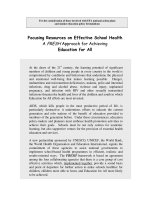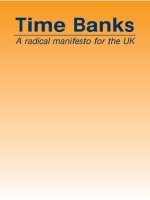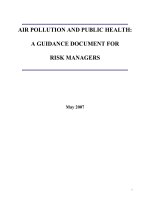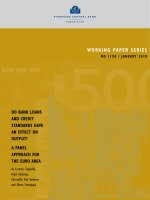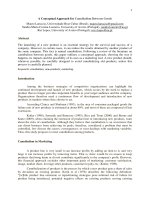Agile People_ A Radical Approach for HR & Managers (That Leads to Motivated Employees)
Bạn đang xem bản rút gọn của tài liệu. Xem và tải ngay bản đầy đủ của tài liệu tại đây (2.03 MB, 256 trang )
ADVANCEPRAISE
“IfthereisanypersonIassociatewithHRandAgile,itisPia-MariaThoren.I
don’t know anyone in Europe who is so dedicated to bringing those critical
areastogether.IhaveworkedwithPia-Mariaonmanyoccasionsandknowher
tobeveryknowledgeableandagreatpleasuretohangoutwith.Abookbyher
handswillcertainlyenduphighonmybacklog.”
—JURGENAPPELO,AUTHOROFMANAGINGFORHAPPINESS
“Pia-MariaisapioneerintheareaofAgileHR.Wesolicitedheradviceinthe
very early days of preparing for our transformation in way-of-work at ING’s
Dutch HR department. Pia-Maria helped us to get good at oversight in the
complex matter of what it takes to become truly ‘agile’ as an HR department.
Anyone interested in agile transformation should be interested in Agile HR
(more appropriately phrased ‘Agile people/employee services’) and I
recommendallofthemtopaycloseattentiontowhatPia-Mariahastosay.”
—ERICABELEN,LEANCOACH,ING
COPYRIGHT©2017PIA-MARIATHOREN
Allrightsreserved.
ISBN:978-1-61961-626-4
DedicationandKudos
Toyou,AgilePeople,forsupportingmeinmymissiontodevelopanetworkdedicatedtocreatingbetter
organizations.Thankyouforputtingallthehardworkintomakingitpossibletorunourmeet-upsand
conferences.Ihopethisbookwillsupportourmissionandthatonedaywewillbeabletolookbackandsee
AgilePeopleasthebeginningofanewworldofwork.
Also,thankyou,Brooke,foryourvaluablesupport.Withoutyou,thisbookwouldneverhavebeenwritten.
Thankyoutoallthecontributorswhohavemadethisbookcomealivebyparticipatingininterviewsand
providingquotesandblurbs.Thebookwasateameffort—inthetrueAgilespirit—morethananindividual
accomplishment,thankstoallyourvaluablecontributions.
Thankyou,JennieandAlexandra,forhelpingmecarryoutalltheinterviews—itwashardwork,butI’m
veryproudoftheresult.
CONTENTS
CONTRIBUTORS
INTRODUCTION
1.THEBIRTHOFAGILE
2.ORGANIZATIONALSTRUCTURES
3.MODERNAGILE
4.PERFORMANCEMANAGEMENT
5.GOALSETTINGANDOKRS
6.AGILEREWARDS
7.AGILERECRUITMENT
8.LEARNINGANDDEVELOPMENT
9.THEREISSMOTIVATIONPROFILE
10.AGILELEADERSHIP
11.AGILEMANAGEMENT
12.AGILETOOLS
13.EMPLOYEEENGAGEMENT
14.AGILEANDTHEBRAIN
CONCLUSION
AGILEGLOSSARY
PRINCIPLESANDPRACTICES
FURTHERREADING
APPENDIX
ABOUTTHEAUTHOR
CONTRIBUTORS
LEILALJUNGBERG,SNOWSOFTWARE
When Leila started to work with HR in the IT community, she soon realized
there was a lot to learn from IT. She infiltrated the competence network that
focused on Agile practices and then started to build an HR function from the
base principles of Agile. They called it Agile HR back then. Nowadays, she
keepsfindingwaysofusingAgilevaluestoevolvepeopleandculturestobethe
best they can be. She strongly believes we all have the leadership within us to
growandworkhardtocreateaninclusiveatmospherewithanimpactonresults.
MATTIKLASSON,KING
Matti thinks motivated and happy people make really innovative and amazing
products that delight their customers! He gives organizations, groups, and
individuals tools and guidance. He helps them remove obstacles and waste to
make it easier for them to grow and develop to be competitive and adapted to
change. With twenty years of experience in systems and software engineering,
MattiisatruebelieverinDevOpsandAgilemovements.
BONNITTAROY,APPASSOCIATESINTERNATIONAL
Bonnitta works with a network of leaders who are bringing participatory
practicesintotheworkplace.SheisfounderofAPPAssociatesInternationaland
a member of the European Center for Leadership Practice. She designs
transformative practices for individuals and hosts collective insight retreats for
groupsatAlderloreInsightCenter.
BJƯRNSANDBERG,PREPARATUS
BjưrnhasworkedinvariouspositionswithinHRandhasbeendeeplyinvolved
inmajortransformationsandchanges,inspiredbyLean|Agile.Bygettinginto
what it really was about, he realized it was possible to start developing next
generationHR.It’sanecessarysteptobeabletosustainablysupportbusinesses
facingafast-changingandcomplexworld.
FABIOLAEYHOLZER,JUSTLEADINGSOLUTIONS
Fabiola is the CEO of Just Leading Solutions, a New York-based consultancy
for Lean | Agile People Operations—the 21st century HR approach. She helps
enterprisestoacceleratetheirAgiletransformationbyfocusingontheircrucial
asset:theirpeople.
RIINAHELLSTRÖM,PEOPLEGEEKS
Riinahasbeenrecommendedinternationallybypeersandstrangersasabrilliant
Agile and people professional. In 2010, she followed her passion and founded
herownconsultancytodrivetheAgileorganizationdevelopmentandAgileHR
scene forward. Her company, Peoplegeeks Ltd Oy, is a modern people and
business consultancy helping clients succeed in business through modern HR,
Agile transformations, Agile management, people analytics, and by digitizing
people services and developing and building modern leadership and
collaborationacrosstheorganization.
CECILIAWESTERHOLMBEER,BISNODE
Cecilia is a business-driven, curious, passionate leader focused on engagement
and change management. She possesses extensive experience in most areas of
strategic organizational development, performance, productivity, change
management, employee and client engagement, workplace strategy, workforce
planning, organizational design, and strategic implementation. Over the last
fifteenyears,she’sworkedinhumanresources,withjobsinmanagementandat
thedirectorandVPlevel.
INTRODUCTION
CHOOSINGTOADAPT
“In the struggle for survival, the fittest win out at the expense of their rivals
becausetheysucceedinadaptingthemselvesbesttotheirenvironment.”
—CHARLESDARWIN
Darwin was an early proponent of adaptability. He believed that plants and
animalsadaptedtonewcircumstancesandchangesintheirenvironmentinorder
tosurvive.Hisfamousphrase,“survivalofthefittest,”referstoaspecies’ability
toadapt,nottoitsphysicalstrength.Theabilitytoadapttoachangingworldis
what allows some species to survive even the most dreadful environmental
changes.Thesameisapplicableforourorganizations.Thedifferenceisthatin
the business environment, we don’t have to wait two million years for the
adaption;wewillsurvivebyactivelychoosingtoadapt.
Choosing to adapt is the heart of the Agile philosophy. In the past, Agile was
primarily associated with software development and the IT sector. Today, it’s
increasinglyusedbyhumanresourcesteamsandappliedtoentireorganizations.
Agileisawayofmovingforwardandcreatingvalue.It’samentalitythatallows
peopleandgroupstomeetchallenges,learnquickly,andrespondtochange.It’s
a different and new way of managing teams, individuals, projects, and
development.
Agile is an operational strategy to meet a rapidly changing and complex
world.
—BJÖRN
Mycolleague,Tomas,introducedmetoAgilein2009,whenIwasworkingasa
projectmanagerinHRandITtransformations.Wewereimplementingatalent
managementsolutionforalargeinternationalmanufacturingorganization.Iwas
struggling with project management because I am not a structured person,
although the job required structure. I did what I had to do, but I wasn’t happy
followingtimeschedules,makingdetailedprojectplans,ormappingoutexactly
whateveryonewassupposedtodoeachday,andwhen.Ilearnedtobehaveina
structuredmanner,thoughit’sagainstmypersonality.AndIdiditwell,butIdid
notfeelgoodaboutmywork.
Theprojectmanagementroledidn’tfeelrighttome.Icouldn’tunderstandwhy,
until I attended a four-day course that transformed my life. My colleague had
read a book about Agile and suggested we attend a workshop to learn how it
couldbeappliedtowhatweweretryingtoaccomplish.Duringthosefourdays,I
learnedtherewasabetterwaytorunprojects,businesses,andevenmyownlife
thantheapproachI’dbeenusing.
In the 1990s, many IT companies embraced the Waterfall approach to
management,whichisalinearandsequentialdesignprocess.Wewereusinga
variation of it for our big project. Agile, on the other hand, is an incremental
approach.Workiscompletedinsmallbatchesorsprints,andthenevaluatedand
tested.Themethodiscollaborativeandallowserrorstobefixedorfeedbackto
betakenintoconsiderationasyoumoveforward.
Laterexperiencesandstudiesofframeworksforpersonalitytraitsalsotaughtme
that people are very different on a foundational level. Some are flexible and
spontaneous by nature and others crave order. How we operate and what
motivatesusisbuiltintothefabricofourDNA.It’salsotaughtduringourearly
upbringing. The Reiss Motivation Profile, which identifies an individual’s
sixteen primary needs, has been an invaluable tool in my life and in working
withothers.It willhelpyoutobetter understandhowyouandyour coworkers
arewiredsoyouknowwhichrolesandpositionsyouwillfindmostfulfilling.
We’llcoveritindepthinChapter9.
I’mnotpronetodiscussingthegenerationalthing,likemillennials,because
to be honest, I think individual changes in people are a lot bigger than a
group born in the ’90s. Still, I think it’s a shift; a shift in expectations. I
don’tthinkit’sonlythemillennials.Ithinkit’sbiggerthanthat.
—LEILA
ThisbookisabouthowtouseAgileprinciplesandpracticesinHRdepartments
and throughout entire organizations. It is intended to inspire people to
experiment with different tools and explore new avenues. Through
experimentation and trust-based management, organizations can expect to
increase employee engagement and ensure longevity in the marketplace.
Although Agile originated in the tech sector, the philosophy applies to
companies large and small in any rapidly changing industry and an everchangingworld.
Youcandoalotofdifferentthingsandbeapartofdifferentcommunities.
Yourworkdaycouldconsistoffiveorsixdifferentelements.IworkparttimeasanUberdriver,andIcanworkpart-timeasanonlineteacher.The
possibilities to work are huge for people who see those kinds of
opportunities.Youdon’treallyhavetohavea9–5workdayanymore.
—LEILA
My goal is to demonstrate, both through my own experiences and through the
experiencesofthecompaniesI’veconsultedwith,thatwhenpeoplefeelbetter,
theyperformbetter.I’llshowyouhowtoadoptnewleadershipandmanagement
stylesthatpromotetheformationofself-directingteams.Together,wecanhelp
peoplefeelsafeandinspiredsotheywillsharetheiruniqueskillsandideasfor
themutualbenefitofindividuals,teams,andentireorganizations.
This book is for anyone interested in fostering more creative and productive
work environments: consultants, customers, executives, employees, and
educators. Those environments attract and retain top-level employees who are
empoweredtobringtheirA-gametothetableeveryday.Myintentionistoshare
Agileprinciplesandpracticessothatwecancreatebetterorganizationstogether,
withouthierarchyorrestriction.Aboveall,thisbookisforprofessionalswithin
HR—adepartmentthatneedstofindanewpurpose.Managersaretakingover
moreandmoreHR-relatedtasksasaconsequenceofcostreductionsandtheold,
controllingHRroleisnotvalidanymore.
The mission for Agile People is both bold and broad, and I believe it has the
power to make a huge difference in the world of work. I hope you find
inspirationinitandallowyourselftoexploreitsvastpotential.Creatingabetter
tomorrowstartstoday.
THEAGILEPEOPLEMISSION
There is a shift happening in the world of work. Organizations are becoming more inspiring, human,
purposeful,andfuture-driven.Businessesarebecomingaforceforgood.People’spotentialisfreedupto
haveapositiveimpactonthelivesofothers,communities,andtheworld.Ourpurposeistoacceleratethis
transformation by spreading the Agile values of customer collaboration, energizing people, inspiring
leadership,andrapidchangetoallareasofbusinessandtoorganizations.
We take pride in being on the front lines of organizational change. We attract people from all types of
industriesthatfulfilladiversesetofroles.Meetingacrossfunctionsenablescross-learning,collaboration,
andnewsolutionsforthefutureofwork.1
1“Mission,”AgilePeopleSweden,accessedSeptember10,2017,
/>
CHAPTER1
1.
THEBIRTHOFAGILE
“Thinkingisthehardestworkthereis,whichisprobablythereasonwhysofew
engageinit.”
—HENRYFORD
My goal for this book is to share how to apply Agile philosophies to an
organization, small or large, new or established. I’ll provide specific exercises
andscenarios,sharesuccessstoriesofcompanieswhoarealreadyenjoyingthe
benefits of Agile thinking, and examine modern challenges and how to
overcomethem.
Webelievewecancomeupwithasolutionforeverysinglethingthatmay
gowrong.Whenthosesolutionsareputintoprocesses,everythingisfine.
HR is driven by hidden forces—mainly legal, finance, and management.
LegalisespeciallyprevalentintheU.S.
—FABIOLA
THEAGILEDREAM
Martin Luther King Jr. didn’t say, “I have a five-year plan.” He moved a
generation of individuals by saying, “I have a dream.” It all starts with a
beautifuldream;creatingAgileorganizationsismine.Adreamhasthepowerto
unite a team, a department, or a whole company, and inspire people to work
toward a common vision. You can run a company without a dream, but you’ll
neverhavepassionateemployees.Ifyou’renotclearontheorganization’swhy,
theemployeeswon’tbeeither.
Theexecutionofstrategy,whichishowdreamsarereached,happenseveryday
between8:00a.m.and5:00p.m.(butwithincreasingfrequency,peopledotheir
workafterofficehoursand/oroutsideoftheoffice).Ifemployeesareonboard
withanorganization’swhy,theywillchoosetoactandmakedecisionsthatlead
towardthewhy,allday,everyday.Decisionmakingandinnovationdon’tcome
fromtop-levelmanagement,oreventhenextleveldown.Thatdoesn’tmeanthat
top management cannot be innovative; it’s simply unwise to rely solely on the
fewattheverytoporonaspecificdepartmentforinnovation.
Veryfewpeopleareinpositionswithenoughpowertoimplementchanges
thatwillactuallybuildthiskindoforganization.Exceptionalcompaniesare
identifiedineachcountry,usuallyfromthe“greatplacestowork”lists,or
somethingsimilar.Theyoftenhaveanownerwhoissobrilliant,theycan
make changes and build systems or organizations that they believe in. It
might not bring the revenue in as quickly as they want, but they are
buildingorganizationsinalastingandorganicway.
—RIINA
Innovationhappenseverywhere,allthetime,andweneedtogivepeoplemore
space and time to be creative where they are. The best way to secure a
company’s future is by constantly innovating and designing new products and
servicesforanever-changingcustomerbase.
Theemployeeleveliswherethingsaredoneandwheretheworkhappens.The
employeesaretheoneswhorealizethedreamorthevisionbydoingwhatthey
do best every day. Therefore, management needs to be completely transparent,
visible, and available to everyone. The whole organization should be asking,
“What can I do to make our dream a reality? What steps need to be taken?”
Everyoneneedstohavetheauthoritytoprioritizetherightthingsasifitwerea
matteroflifeanddeath,becausetherealityis,itis.Ifwedon’tpayattention,we
willbeoutrunbysmaller,faster,andsmarterplayersinnotime.
THEWAYITWAS
The workplace and the preferences of employees have changed dramatically
over the last century, especially in the last twenty years. Power used to be a
function of position within a hierarchical structure (and still is in many
companies). A hundred years ago, most companies functioned as a machine.
Employees were a big part of that machine. Management’s challenge was to
maketheirsystemsasefficientaspossible.Theemphasiswasonstandardization
andlogistics.Peoplewereresources;theywereeasilyexchangeablepartswithin
theorganizationalmachinery.Mostpeoplewerenotrequiredtothinkatalland,
today,robotshavereplacedmanyworkers.
Oneofthefirstbusinessconsultants,andaleadingmechanicalengineerduring
the industrial era, Fredrick Taylor, developed a scientific management system.
His main objective was to improve economic efficiency and improve labor
productivity.
Taylor’s ideas and research impacted many famous benchmarks of efficiency,
suchastheprocessesadoptedontheFordfactoryassemblylines.Humanslined
up and repeated the same task consistently, day in and day out. The workflow
wasanalyzed,evaluated,improved,andstandardized.Hispracticeswerehighly
effective for meeting the challenges of industrial manufacturing and logistics,
andwerelargelyresponsibleforthecreationoftheproductionline.Peoplewere
notusedfortheirbrains,justtheirphysicalstrength.
As ordinary people, we haven’t changed, but the context in which we are
beingbroughtuphasdisruptivelychanged.Intheschoolsystemstoday,we
have a democratic situation where, for example, the student and teacher
agreeontargets.Thestudentsseemtohaveanacceleratedlevelofpowerin
termsofinfluencingtheirowndevelopmentandlearning.Today’sstudents
can have a different opinion than the professor/teacher and still get good
grades. However, when these students graduate, they are tossed into
organizations that are still run in a machine-like, bureaucratic, and
Tayloristicmanner.Thisleadstoabigclashintheirinitialgoals,sincethey
more or less have to do what they are told. We hire people for their
creativityandideas,butinmostcases,westilltreatthemasmachines.
—BJÖRN
Many photographs exist from this era: men in overalls on factory floors and
women in neat lines with sewing machines or ironing boards. Their clothing,
behaviors,andresponsibilitieswerecarefullydictatedaccordingtotheirrankin
the manufacturing system. Senior executives determined an organization’s
strategy without input from employees or customers. Everyone reported to a
boss.Taskswereassigned,notchosen.
Managersgaverewardsforworkwelldone,butemployeesdidnotrewardone
another. Compensation correlated directly with one’s rank within the
organization. Promotion was a measure of achievement and autonomy was
uncommon.Thefewpeopleatthetopmadeallthedecisionsbecausetheywere
thoughttobesmartenoughtounderstandhowworkshouldbedone.Hierarchies
ruledandformalpower,reservedforthechosenfew,wasasignofsuccess.
WORKLIFETODAY
Today, the economy has shifted from industry—via knowledge—to the
participation age, but remnants of industrial practices still exist. Our challenge
nowistokeepupwiththepaceoftechnologicalprogress.Todoso,weneedto
tapintothehumanpotentialforcreativity,asopposedtoplacingpeopleinrigid
positions with zero flexibility. To remain competitive, we need to change and
growconstantly.
Today, we see only a few early adapters who are really changing
workplacesandmakingapositiveimpactonhowworkisdone,managed,
controlled, and planned. I think we are just seeing the tip of the iceberg
now.Ibelieve,inthenearfuture,wewillseemoreproductsbeingsoldthat
have substantially increased levels of technology, such as artificial
intelligence and robotics that will basically disrupt the way people work.
I’mnotsureiftheaverageworkingindividualreallyunderstandsthisyet.
I’mnotevensureifIunderstandit.Ijustknowsomethingbigisgoingto
happenandchangeiscomingreallyfast.
—RIINA
Theknowledgeerademandsfreethinkingandexperimentationtosurvive.Lean
is a powerful concept from Toyota, where the underlying principles of
involvementandrespectforworkersarecorevaluesandessentialforsuccess.
Continuous improvement is still a theme, and it manifests through the
acceptanceorexplorationofinnovativeideas.Itrequiresallowingpeopletofail
(inordertolearn),ratherthanjustfocusingonsystemefficiencies.
Inmyexperience,“workplace”nowadaysisafluidterm.It’snolongera9–
5environment.
—LEILA
Increasing flexibility in the workplace means that people are less inclined to
acceptbeingtoldwhattodoorbeapartofthemachinery.Ofcourse,thereare
stillseveralstructuredorganizationswhereeverymovementisdocumentedand
graded.McDonald’sandotherfranchisedrestaurantsareagoodexample.These
establishments are managed using detailed checklists, processes, and systems.
Theworkitselfdoesnotrequireanyspecificskillsets,creativity,innovation,or
individuality. In fact, employees are hired specifically to follow instructions.
Franchises are based on the factory model, which works fine for companies
whoselaborforceisanexpendable,exchangeableresource.
We always design our HR processes for the worst possible scenario and
person.WecallittheDouglasEffect.ImagineDouglasistheworstperson
youwouldwantinyourworkplace.Heembodiesallsortsofbadbehaviors
and character traits. Everything we do in HR is designed to help keep
Douglasincheck.
—FABIOLA
THEHISTORYOFAGILE
Inthe1970s,aprojectmanagementsystemknownastheWaterfallModelwas
widely popular. There are many variations of this approach but, at its heart,
progressismeasuredinsequentialstages.Developmentflows,likeawaterfall,
through the different project phases. Its roots are in the manufacturing and
constructionindustrieswhereitiscostly—andsometimesimpossible—tomake
changes.
It started out as an IT thing. They had to come up with new systems and
ways of working in fast-paced times when everyone depended on
collaboration.
—FABIOLA
Consequently, there is little room for flexibility or errors. Once a step is
complete, the team cannot go back and make improvements. The Waterfall
approachrequiresextensivepreplanningandzerodeviationfromtheplan.Itis
not terribly effective for software development, which is abstract and always
changing. Five-year project timelines and rigid project phases don’t allow for
shiftsinthemarketplaceorcustomerfeedback.Onceaprojectleavesonephase
andentersanother,there’snoturningback.
Many people assume that finishing a step is a good thing. The problem,
however, is the Waterfall Method presupposes that the world is predictable,
which it categorically is not. In using the Waterfall Method for project
management, many companies found that projects and feedback loops were
stretchedoutoververylongperiodsof time,oftengoingwayoverbudgetand
usingfarmoreresourcesthanoriginallyanticipated.It’sanantiquatedapproach
that doesn’t suit the pace of change in today’s world. The failure rate is
extremelyhighbecausewecannotcontrolchange,andchangeisareality.Realtimefeedbackisneededtodevelopthebestandmostusefulproducts.
TheAgilemovementfirststartedintheITsoftwaredevelopmentindustryasa
reactiontotheWaterfallModel.Therewasaneedforincreasedagilitybecause
thingsrarelygoaccordingtoplan.Everyday,peoplegetsickorquit,managers
leave, and projects fail. The only true reality is that we must adapt in order to
survive.Wehavetoassumethatwedonotknowandcannotplanforwhatwill
happeninthefuture.
Work has changed in the sense that one person cannot do the job without
otherpeople’shelp.Iwouldsaythat’sthemostbasicandbiggestchange.
Very few of us can sit in a room by ourselves and get our work done
without more and more networking, more and more communication with
otherpeople,andmoreandmorecollaboration.
—RIINA
AsareactionagainsttheWaterfallModelandtheproblemsthatcamewithit,a
group of IT professionals got together in Snowbird, Utah, in 2001 to discuss a
better way to work with change. Developers and project managers were
frustrated with the traditional model. They wanted to improve IT development
and implementation and be more flexible. Out of their gathering, the Agile
Manifestowasborn.2
Ithinkeverythingchangedduringtheageofdisruption,andobviouslythat
doesn’tstopbecauseofHR,sothereisadifferenttalentcontractinplace.
Peoplehavevaryingviewpointsonwhattheywanttogetoutofworkand
howtheywanttobeincludedinthewaytheywork.
—FABIOLA
MANIFESTOFORAGILESOFTWARE
DEVELOPMENT
Weareuncoveringbetterwaystodevelopsoftwarebydoingitandhelpingothersdoit.Throughthiswork
wehavecometovalue:
1. Individualsandinteractionsoverprocessesandtools
2. Workingsoftwareovercomprehensivedocumentation
3. Customercollaborationovercontractnegotiation
4. Respondingtochangeoverfollowingaplan
Thatis,whilethereisvalueintheitemsontherightsideofeachsentence,wevaluetheitemsontheleft
more.
THEAGILEPRINCIPLES
Wefollowtheseprinciples:
Ourhighestpriorityistosatisfythecustomerthroughearlyandcontinuousdeliveryofvaluable
software.
Welcomechangingrequirements,evenlateindevelopment.Agileprocessesharnesschangefor
thecustomer’scompetitiveadvantage.
Deliver working software frequently, every couple of weeks to couple of months, with a
preferenceforashortertimescale.
Businesspeopleanddevelopersmustworktogetherdailythroughouttheproject.
Buildprojectsaroundmotivatedindividuals.Givethemtheenvironmentandsupporttheyneed,
andtrustthemtogetthejobdone.
Themostefficientandeffectivemethodofconveyinginformationtoandwithinadevelopment
teamisface-to-faceconversation.
Workingsoftwareistheprimarymeasureofprogress.
Agileprocessespromotesustainabledevelopment.Thesponsors,developers,andusersshould
beabletomaintainaconstantpaceindefinitely.
Continuousattentiontotechnicalexcellenceandgooddesignenhancesagility.
Simplicity—theartofmaximizingtheamountofworknotdone—isessential.
Thebestarchitectures,requirements,anddesignsemergefromself-organizingteams.
Atregularintervals,theteamreflectsonhowtobecomemoreeffective,thentunesandadjusts
itsbehavioraccordingly.
TheAgileManifestoistherootfromwhichallAgileprinciplesandtoolsstem.Youcanalwaysgobackto
themanifestoandgetguidance,whenindoubt.That’swhywesaythatAgileisnotamethod,model,tool,
orframeworkinitself.It’samindsetthatresonateswiththevaluestructurefromtheAgileManifesto.
WHATWENEEDNOW:AGILEPRINCIPLES
WhenIwasintroducedtotheAgilephilosophy,Iwasimmediatelydrawntoits
values and principles. They made sense to me and seemed a superior way to
approachwork.
Theemphasisofthephilosophyisonsatisfyingthecustomerthroughcontinuous
value delivery. What’s more, the focus is on happy people rather than
bureaucracy and rigid processes. IT companies and software startups have
readily embraced Agile principles as well, but there is huge potential for
organizational change across multiple industries and disciplines through Agile.
The impact will be monumental for management and HR, especially in areas
suchasemployeerecruitment,training,motivation,engagement,compensation,
development,andperformance.
A lot of people are talking about Agile HR. It’s on the trending list at
Deloitte,KPMG,andsimilarcompanies.Althoughthey’realltalkingabout
AgileHR,veryfewpeopleactuallyknowwhatAgileisabout.Theydon’t
understand where it comes from, why it exists, and the background on its
complexity. It’s too simple to talk about Agile HR and remodeling. In
reality,it’snotaboutthat.
—RIINAWE’VEALREADYSEENDRAMATICCHANGESIN
THEWORKPLACEASWE’VESHIFTEDFROMTHE
INDUSTRIALAGETOTHEKNOWLEDGEECONOMYAND,
NOW,INTOTHEPARTICIPATIONAGE.THEREIS
TREMENDOUSROOMTOGROW,HOWEVER.PEOPLENEED
TOBEGIVENTHEFREEDOMTOCREATEANDEXPERIMENT
SOTHEYCANEXPLORENEWHEIGHTSANDIDEAS.DESPITE
THISNECESSITY,MUCHOFMANAGEMENT’SFUNDAMENTAL
MINDSETISSTILLROOTEDINTHEIDEASOFFREDRICK
TAYLORANDTHEOLDFACTORYMENTALITY.TOKEEPUP
INTODAY’SWORLDANDBEABLETOCOMPETE,
MANAGEMENTNEEDSTOCHANGEWITHTHETIMES.
Top-down, hierarchical organizations are no longer effective in today’s
workplaces.Itisnotpracticalorrealistictoassumethatanentirecompanycan
bemanagedfroma controltower,farremovedfromthepeoplewho aredoing
the actual work. Decision-making power needs to be delegated throughout all
partsofanorganization.Authoritycannotberelegatedexclusivelytothetop;it
needstofilterthroughalldepartments.
Fromalong-termperspective,theworkplacehaschanged,butIbelieveit
looks the same as it did twenty years ago. Although there is a change in
motion from the Agile perspective; the organizations that are easily
changeablewillbetheonesthatthrive.
—BJÖRNULTIMATELY,ACOMPANYSHOULDBEA
NETWORKOFSELF-STEERINGNODES,INSTEADOFATOPDOWNCONTROLLEDORGANIZATION.PEOPLENEEDTOBE
GIVENTHEFREEDOMTOACTLOCALLY,MAKEDECISIONS
QUICKLY,ANDCOMMUNICATEFREELYWITHOTHER
DEPARTMENTSANDCUSTOMERSINREALTIME.WHEN
EMPLOYEESNEEDTORUNEVERYQUESTIONORIDEAPAST
AMANAGER,INVARIABLYRESPONSETIMESLOWSDOWN.
THISWILLLOOKDIFFERENTDEPENDINGONTHECOMPANY
ANDTHEINDUSTRY,BUTESSENTIALLYCOMPANIES
SHOULDFUNCTIONLIKEANETWORK,INSTEADOFA
MACHINE—ALWAYSMOVING,CHANGING,ANDADAPTING
TOTHEEXTERNALWORLD,CUSTOMERS,AND
ENVIRONMENT.
Modern HR departments need to embrace a bottom-up approach to foster
efficient communication and empower staff members to make decisions faster.
Moving away from a bureaucratic structure simplifies operations. There are
fewer processes, systems, reports, and checklists to gobble up management’s
timeandenergy,whichmeansthattimecanbebetterspentonfacilitatingwork
within the team. Do they have everything they need in place to be able to
perform in an optimal manner? Time can also be better spent aligning and
communicating with other departments within the company to ensure smooth
cooperation.Theintentionistocreateagreatworkenvironmentforemployees
andvalueforcustomers.
I always say it’s the business of disrupting HR because, at the end of the
day,that’swhatitis.Everyonetalksaboutthedifficulttimeswehave,or
they say certain things don’t work anymore. But, they don’t have the
courageorthestaminatosay,“Okay,let’schangeit.”Theythinkthereare
easyfixestohugeproblems,butwecan’tapproachnewproblemswiththe
oldwayofthinking.
—FABIOLAWHENHAPPYPEOPLESERVECUSTOMERS,WE
KNOWTHATTHEYWILLBEMORESATISFIEDANDLOYAL
TOOURCOMPANY.WEALSOKNOWTHATASATISFIEDAND
LOYALCUSTOMERISAPROFITABLECUSTOMERWHOCAN
CONTRIBUTETOAPROFITABLECOMPANY.APROFITABLE
COMPANYCANREINVESTINEMPLOYEESANDHASA
GREATERPROBABILITYOFREACHINGITSLONG-TERM
GOALSANDREALIZINGTHECOMPANY’SVISION.IF
MANAGEMENTISWISE,ASUBSTANTIALPARTOFTHE
PROFITSHOULDBEREINVESTEDINMAKINGSURETHAT
ALLEMPLOYEESHAVETHEPREREQUISITESFOR
ENGAGEMENTANDGREATPERFORMANCE.
Another issue in today’s organizations is the over belief in projects. Instead,
organizationsneedtomoveawayfromproject-basedmethods,whereteamsare
put together to accomplish a specific task or goal. The people on the team are
usually strangers. You can’t expect a new team to perform well when it first
comes together. It takes time, sometimes years, for them to get to know each
otherandfindanefficientwayofworkingtogether.Ifyoubreakuptheteamat
the end of the project, just when team members started to work well together,
youwillneverreapthebenefitsfromhigh-performingteamwork.
Organizations should move toward the creation of stable, high-performing
teams,andthistakestime.Thereisextensiveresearchonteamdevelopmentand
group processes made by Susan Wheelan (Integrative Model of Group
Development, or IMGD), Bruce Tuckman (Norming, Storming, Forming,
Performing Model) and William Schutz (Fundamental Interpersonal Relations
Orientation,orFIRO).Theirresearchshowsthathigh-performingteamshaveto
go through a number of phases before reaching the performance stage. Read


